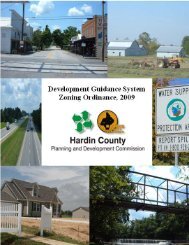2008 Comprehensive Plan - Hardin County Government
2008 Comprehensive Plan - Hardin County Government
2008 Comprehensive Plan - Hardin County Government
Create successful ePaper yourself
Turn your PDF publications into a flip-book with our unique Google optimized e-Paper software.
Redevelopment IncentivesA number of older areas of the county have had less demand for new development.To encourage development in these areas tax abatements could be offered as wellas other incentives to direct economic growth into these areas suitable fordevelopment. The county could waive building or utility fees for new construction inthese areas. If the fees cannot be waived, the county should investigate othermeans for payment of these fees. Other areas of the county where development isdesired may need commitment of road, water, sewer, and other community servicesto increase the attractiveness of these areas.Adequate Public Facilities ProgramOne of the simplest growth management techniques is the use of an adequatepublic facilities program (APF) that requires that new development be approved onlywhen and if adequate public facilities will be available to serve it at the time ofactual development. Also, know as a “concurrency” requirement, this approachprovides standards for ensuring that new facilities are available concurrent with thedemand for those facilities created by new development.An adequate public facilities program requires several elements. First, minimumlevels of service standards are needed in order to define “adequate” for varioustypes of services. These standards may be of an engineering nature for servicessuch as sewer, water, and roads, while policy judgments are often necessary forother types of services such as fire protection, libraries, and parks.Typically, most communities require regulations that a developer provide on sitepublic facilities within a particular development through the use of subdivisionregulations. An adequate public facilities program addresses the off-site facilitiesthat may be affected by development of land.Impact FeesAn impact fee is a tool that requires a developer to pay a proportional share of thecost of expanding off-site public facilities that are affected by a particulardevelopment. It is a more system wide approach than an adequate public facilitiesprogram. Impact fees are most commonly used for roads, sewer, water, and parks.The purpose of impact fees is to create a method of transferring some of thecommunity’s costs for growth onto the developer.The use of impact fees are closely associated with capital facilities planning in thatthey require the existence of a public facility plan tied to growth forecasts, costestimates for public improvements, and a rational allocation of those costs toanticipated new development.Impact fees can be an effective tool for mitigating the cost of new development;however, it may not be used to cure existing deficiencies unrelated to newdevelopment.<strong>2008</strong> <strong>Comprehensive</strong> <strong>Plan</strong>







